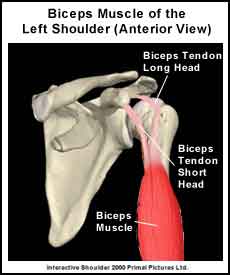In order to understand this condition it is important to understand the anatomy and function of the shoulder. Please read Shoulder Pain Info ‘s section on basic shoulder anatomy. For additional background information on the biomechanics of the shoulder please read Shoulder Pain Info ‘s section on basic shoulder biomechanics.

What is the anatomy of the biceps muscle and its tendons?
The biceps muscle is a large muscle located in the front of the upper arm. It is divided into a short head and a long head. The biceps attaches distally onto the forearm and attaches proximally to parts of the scapula.
Tendons connect muscles to bone. In the front of the shoulder the tendon of the short head of the biceps muscle attaches to the coracoid process. The tendon of the long head of the biceps muscle runs across the glenohumeral joint and attaches to the top of the glenoid (a part of the scapula). The tendon of the long head of the biceps muscle can also be called “the long head of the biceps tendon”.
There are four muscles (supraspinatus, infraspinatus, subscapularis and teres minor) that surround the glenohumeral joint. These four muscles are attached to the scapula. They turn into tendons, which in turn attach to the humerus. The tendons of these four muscles make up the “rotator cuff” that blends into and helps support the glenohumeral joint capsule. The muscles of the rotator cuff and their tendons provide stability to the glenohumeral joint when the arm is in motion. The long head of the biceps tendon provides added stability to the glenohumeral joint.
What is biceps tendonitis?
Biceps tendonitis is an inflammation of the long head of the biceps tendon, as well as its paratendon (the sheath surrounding the tendon). It often occurs as a result of overuse or chronic “wear and tear”. Overuse can cause microscopic tears to form in the tendon. These tears trigger an inflammatory response, which causes pain.
What causes biceps tendonitis?
As mentioned above this condition often occurs as a result of overuse. It can be caused by excessive overhead motions such as throwing or swimming. With these types of activities, there is excessive wear on the tendon, but other factors may contribute to the problem. The long head of biceps tendon is normally held in its groove by the transverse humeral ligament. If the ligament is injured or stretched the long head of biceps tendon may slide abnormally resulting in irritation of the tendon. The bicipital groove (the groove in the head of the humerus or upper arm bone) itself may also be deformed. If it is too shallow or has rough edges it can also cause irritation of the tendon.
What does biceps tendonitis feel like?
Pain related to biceps tendonitis is usually felt over the front of the shoulder, often with some radiation to, but not usually beyond, the elbow. Typically, the pain is aggravated by overhead activity and is worse at night. People may report a clicking or popping sensation in the affected shoulder.
Can biceps tendonitis be detected on X-rays?
The diagnosis of biceps tendonitis is usually made on the basis of the medical history and physical examination and cannot be identified on X-ray. Doctors may order an X-ray to look for bony abnormalities. An MRI scan is a special imaging test that uses magnetic waves to create pictures that show the tissues of the shoulder in slices. An MRI scan shows tendons as well as bones. An MRI scan is painless and requires no needles and may be helpful in diagnosing biceps tendonitis.
To diagnose biceps tendonitis, a physician or physical therapist may use a special test such as Speed’s Test / Speed’s Maneuver or Yergason’s Test.
What is the treatment for biceps tendonitis?
Biceps tendonitis is usually treated conservatively. Treatment may include stretches, strengthening exercises, anti-inflammatory medications, rest or activity modification, and/or heat/cold therapy. In some cases a cortisone injection may be required to help decrease the pain and inflammation. Doctors and physical therapists that deal with people who have biceps tendonitis can help outline a treatment program.
What other information is available on biceps tendonitis?
Shoulder Pain Info ‘s links section has additional information on this topic. Links have been provided to other websites as well as online medical journals.
